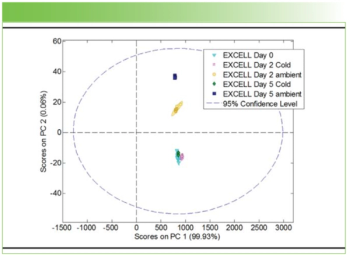
The Future of Raman Spectroscopy: The Role of TERS and SERS
Attend any conference covering vibrational spectroscopy, and you will likely hear numerous talks about developments in tip enhanced Raman scattering (TERS) and surface-enhanced Raman scattering (SERS). Both approaches hold exciting promise, but face significant challenges as well. We asked a panel of Raman experts about the current and future role of these two approaches.
Attend any conference covering vibrational spectroscopy, and you will likely hear numerous talks about developments in tip enhanced Raman scattering (TERS) and surface-enhanced Raman scattering (SERS). Both approaches hold exciting promise, but face significant challenges as well. We asked a panel of Raman experts about the current and future role of these two approaches.
TERS
Many problems at the frontiers of materials science require spatial resolution that is outside of the diffraction-limited regime. Sub-diffraction-limited approaches like TERS seem to offer the potential to bridge this gap, but currently the approach does not appear to be practical because of the difficulty in preparing tips. So we asked our experts if they thought TERS-like approaches to Raman imaging would someday become more practical.
“This remains an important opportunity for Raman spectroscopy that could be put to work today with practical instrumentation offerings and a ready source of appropriate tips,” said Dennis J. Walls, a senior research associate at DuPont. “In addition to biological systems, the increasing importance of structural organization at the nanoscale in materials science calls for characterization approaches that can operate in this size regime.”
Zachary D. Schultz, an associate professor of chemistry and biochemistry at the University of Notre Dame, said he was not sure if the difficulty is really preparing tips. “I think the biggest obstacle to TERS is false expectations,” he said. “Many TERS tips perform exactly as expected; however, the observed signal enhancement from a single nanostructure on a single or small number of molecules, or in complex samples, is not always that large.”
Schultz added that the advances in commercial TERS instruments is helping practicality, but also increasing frustration when people cannot get the expected result. “I think TERS has significant potential and will be an important technique, but it will also have its limitations,” Schultz said. “As the technique matures, people will better appreciate what it can and cannot do.”
Juergen Popp, a professor of physical chemistry at Friedrich-Schiller University Jena and the Leibniz Institute of Photonic Technology Jena, mentioned several examples that show how TERS-like approaches are becoming more practical, such as in the characterization of single viruses and in protein analysis. “TERS has made a lot of progress within the last few years, especially with respect to practical life science or biomedical applications,” he said. “I am convinced that the difficulties in preparing reproducible TERS tips will be overcome soon.”
SERS
SERS offers the potential to increase the sensitivity of Raman spectroscopy in a wide range of systems. We asked our experts if SERS-based solutions have become easier for nonexperts to apply, and whether SERS is likely to become more universally applicable in the near future.
All agreed that the lack of reproducible substrates-and having them commercially available-is the biggest obstacle to more widespread use of SERS.
“One commercial supplier recently discontinued a SERS substrate product,” lamented Schultz. “A few other products have emerged as possibilities, but the development of a robust high-enhancement substrate would facilitate use by nonexperts,” he said.
Heinz W. Siesler, a professor at the University of Duisburg-Essen, agreed. “Once commercial substrates are available, SERS will become more universally applicable.”
Several panelists noted that there are many efforts underway to try to address this challenge. “Recent advances in producing colloids with reproducible size and morphology are helping to address this problem,” said Reffner.
Popp agreed. “One of the most promising approaches in my opinion is the usage of colloidal silver or gold nanoparticles, which are easy to prepare together with microfluidic chips,” he said.
Despite the reproducibility problem, Popp thinks that lab-on-a-chip SERS concepts are very promising, particularly for drug and metabolite monitoring. “The routine analytical application of SERS comes down to the availability of reproducible SERS substrates,” he said. “Once such SERS substrates are available, SERS-based solutions will be easy to apply-even for nonexperts-making them universally applicable.”
Gary Johnson, a research Chemist at Intertek, is less optimistic. “I see SERS as a method that works well for very specific types of samples, but not so much as a general analytical technique,” he said.
This article is an edited excerpt of “
The article is part of a special group of six articles covering the state of the art of key techniques, also including
Newsletter
Get essential updates on the latest spectroscopy technologies, regulatory standards, and best practices—subscribe today to Spectroscopy.




